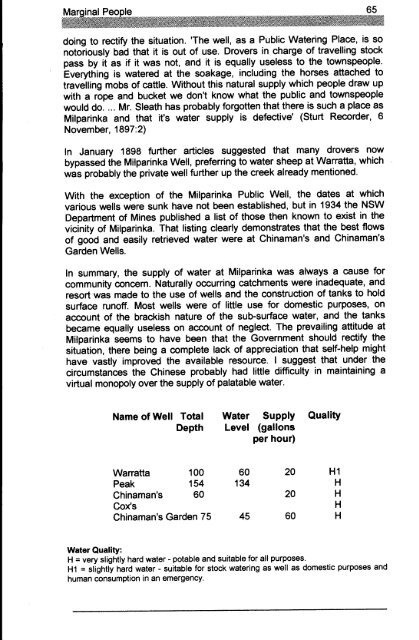Adec Preview Generated PDF File - The Sydney eScholarship ...
Adec Preview Generated PDF File - The Sydney eScholarship ...
Adec Preview Generated PDF File - The Sydney eScholarship ...
Create successful ePaper yourself
Turn your PDF publications into a flip-book with our unique Google optimized e-Paper software.
doing to rectify the situation. '<strong>The</strong> well, as a Public Watering Place, is so<br />
notoriously bad that it is out of use. Drovers in charge of travelling stock<br />
pass by it as if it was not, and it is equally useless to the townspeople.<br />
Everything is watered at the soakage, including the horses attached to<br />
travelling mobs of cattle. Without this natural supply which people draw up<br />
with a rope and bucket we don't know what the public and townspeople<br />
would do.... Mr. Sleath has probably forgotten that there is such a place as<br />
Milparinka and that it's water supply is defective' (Sturt Recorder, 6<br />
November, 1897:2)<br />
In January 1898 further articles suggested that many drovers now<br />
bypassed the Milparinka Well, preferring to water sheep at Warratta, which<br />
was probably the private well further up the creek already mentioned.<br />
With the exception of the Milparinka Public Well, the dates at which<br />
various wells were sunk have not been established, but in 1934 the NSW<br />
Department of Mines published a list of those then known to exist in the<br />
vicinity of Milparinka. That listing clearly demonstrates that the best flows<br />
of good and easily retrieved water were at Chinaman's and Chinaman's<br />
Garden Wells.<br />
In summary, the supply of water at Milparinka was always a cause for<br />
community concern. Naturally occurring catchments were inadequate, and<br />
resort was made to the use of wells and the construction of tanks to hold<br />
surface runoff. Most wells were of little use for domestic purposes, on<br />
account of the brackish nature of the sub-surface water, and the tanks<br />
became equally useless on account of neglect. <strong>The</strong> prevailing attitude at<br />
Milparinka seems to have been that the Government should rectify the<br />
situation, there being a complete lack of appreciation that self-help might<br />
have vastly improved the available resource. I suggest that under the<br />
circumstances the Chinese probably had little difficulty in maintaining a<br />
virtual monopoly over the supply of palatable water.<br />
Name of Well Total<br />
Depth<br />
Warratta 100<br />
Peak 154<br />
Chinaman's 60<br />
Cox's<br />
Chinaman's Garden 75<br />
Water Supply Quality<br />
Level (gallons<br />
per hour)<br />
60<br />
134<br />
Water Quality:<br />
H = very slightly hard water - potable and suitable for all purposes.<br />
H1 = slightly hard water - suitable for stock watering as well as domestic purposes and<br />
human consumption in an emergency.<br />
45<br />
20<br />
20<br />
60<br />
H1<br />
H<br />
H<br />
H<br />
H




